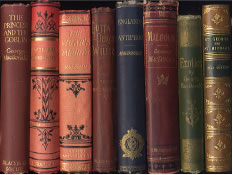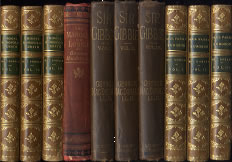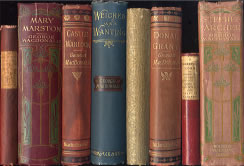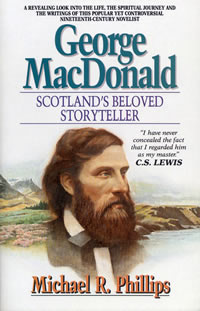“George MacDonald has influenced the development
of my character, desires, and passion for helping
others. I was challenged by Robert Falconer to have
a love for those in distress in the city…I
learned to trust along with little Annie Anderson,
and to hurt with Juliet. I admired God’s glorious
handiwork with Alister…With Thomas Wingfold
I learned tolerance is bred from a true relationship
with Christ.”
—TM |
|
Dealings
with the Fairies
1867,
Alexander Strahan, MacDonald's first published collection of
short stories, which included: The Light Princess, The Giant's
Heart, The Golden Key, Cross Purposes, and The Shadows. In future
years, collections of MacDonald's short stories and fairy tales
were reprinted in many collections and formats by a wide variety
of publishers. This particular collection, sometimes with others
added, more commonly came to be published as The Light Princess
and Other Fairy Stories, but also as Cross Purposes and
the Shadows, or simply Fairy Tales. The reprints
are too numerous and too similar to mention individually.
The
Disciple and Other Poems
1867,
Alexander Strahan, a second full volume of poems, including
"The Disciple," a lengthy narrative poem which traces in part
MacDonald's own autobiographical spiritual journey out of the
Calvinistic tradition of his past and into a new and personal
faith of his own.
“The Musician’s Quest has become
to me the most enjoyable, challenging book that
I have ever read of its kind…even months later
it still kindles in me a greater desire to be a
servant like Robert Falconer, and ultimately, like
Jesus Christ.”
—PH |
|
Guild
Court: A London Story
1868,
Hurst & Blackett, one of MacDonald's lesser known but imminently
worthwhile stories set in London.
Robert
Falconer
1868,
Hurst & Blackett, perhaps MacDonald's most well-known novel
and life story of his most memorable character. The character
of "Robert Falconer" had been with MacDonald a long time, first
from the unpublished Seekers and Finders (1859-60), then
appearing briefly in David Elginbrod, and later in a
much abbreviated story serialized in 1866-67 called "The History
of Robert Falconer." Now at last Falconer's full story came
to light. Robert Falconer, like Alec Forbes of Howglen,
is a highly autobiographical work, with this difference, that
in the character of young Robert Falconer the reader gains a
rare glimpse into MacDonald's own boyhood, with his internal
struggles, his relationship with his grandmother (who largely
raised him after the death of his mother) and his spiritual
search as a young man attempting to discover God's love amid
the hellfire Calvinism of his upbringing. Robert Falconer's
resolution of this conflict is a wonderful window into the roots
and development of MacDonald's own faith which would turn generations
to come toward the Fatherhood of a loving God.
England's
Antiphon
1868,1874,
Macmillan, a study of the history of religious poetry in England.
The
Seaboard Parish
1868,
Tinsley Brothers/Routledge, a sequel to Annals of a Quiet
Neighborhood. Set in the English seaside town of Bude and
based on a MacDonald family holiday there, this novel contains
one of MacDonald's less striking "plots" yet is fuller than
most with spiritual insights, gems, and teaching.
The
Miracles of Our Lord
1870,
Strahan & Co. MacDonald's second volume of "sermons" in
which he studies in some detail, by type, all the reported miracles
of Jesus.
 At
the Back of the North Wind
At
the Back of the North Wind
1871
(Dec.,1870), Strahan & Co, Probably in historical perspective,
North Wind ranks as George MacDonald's most well known
and enduring book, the haunting tale of Diamond, a simple London
cabman's son. It is likely that it has been published in more
editions, by more publishers, and been read by more people than
any of his other works. Its skillfully woven intermingling of
realism and fantasy continued to set MacDonald apart as a writer
of uniqueness in distinction in the early 1870s as his reputation
and fame steadily mounted.
Ranald
Bannerman's Boyhood
1871,
Strahan & Co. Turning from North Wind, MacDonald
here released his first "juvenile" realistic story, set in Scotland
in and around MacDonald's hometown of Huntly. Largely taken
from autobiographical incidents (as are boyhood sections of
Alec Forbes, Gutta Percha Willie, and Robert Falconer),
Ranald Bannerman presents the lighter side of MacDonald's
boyhood in fictional form.
“Characters
like Malcolm or Gibbie or Annie give me hope as
I see the simplicity of their faith.”
—RE |
|
Works
of Fancy and Imagination
1871,
Chatto & Windus. As MacDonald's reputation and the success
of his books rose in popularity in both the U.S. and Great Britain,
new editions began appearing at an increasing rate. This collection
is one that would not have been possible had MacDonald's popularity
not been great. It offers a reprint of some of his most popular
works in a 10 volume small sized gift set. Included are: Within
and Without, most of the poetry from Poems and The
Disciple, Phantastes, The Portent, The Light Princess, Cross
Purposes, The Golden Key, and ten additional short stories.
Wilfrid
Cumbermede,
1871,
1872, Hurst & Blackett/Scribners. A realistic novel some
of whose themes grew out of the relationship between George
and Louisa MacDonald and author John Ruskin during a troubled
time in the latter's life. Some of the descriptive portions
contained within this narrative, especially of the Swiss Alps,
are among MacDonald's finest.
|
“I
for one can really testify to a book that has made
a difference to my whole existence, which helped
me to see things in a certain way…It is called
The Princess and the Goblin, and it is
by George MacDonald.”
—G.K. Chesterton, 1924 |
|
The
Vicar's Daughter,
1871
(Robert Bros., US), 1872 (Tinsley Brothers, UK), a sequel to
The Seaboard Parish, and following the early married life
of one of the Walton daughters, this third book in what is sometimes
called "The Marshmallows Trilogy" is even less dramatic of plot
than its prequel, demonstrating that (though he was paid a tremendous
sum for it in comparison to the fifty pounds or less he received
for some books), his remarkable output and quality notwithstanding,
not every one of MacDonald's titles can be considered
a masterpiece. Its characterization of MacDonald's friend and
patron Lady Byron, however, is noteworthy.
“Suddenly it seemed I reached the point where
Gibbie…became real and imperative. He took
me by the hand…and led me…up the slopes
of Glashgar where he ran through the heather with
the sheep…
“[Sir Gibbie] moved me the way books did when,
as a child, the great gates of literature began
to open and first encounters with noble thoughts
and utterances were unspeakably thrilling.”
—Elizabeth Yates, in the Introduction to her
edited edition of Sir Gibbie, 1963
|
|
The
Princess and the Goblin
1872
(Dec. 1871), Strahan & Co./Routledge. Along with North
Wind, the two "Curdie books," of which The Princess and
the Goblin is the first, represent the high water mark of
MacDonald's "fairy tale" stories. Though the opening scenes
in Phantastes and Lilith surely stimulated the
transitional "entryway" vehicle used in the seven books, there
can be little doubt that the overall concept and flavor of Lewis's
The Chronicles of Narnia has its origins with the publication
of The Princess and The Goblin and its sequel. This is
one of MacDonald's finest books and yet again demonstrated,
not merely his versatility as an author, but a versatility of
excellence at the highest level.
Gutta
Percha Willie
1873,
Henry S. King. The full title, Gutta Percha Willie, the Working
Genius, this was a second "juvenile" novel, unconnected
with but written for a similar reading audience as Ranald
Bannerman's Boyhood.
 Malcolm
Malcolm
1875,
Henry S. King/Lippincott. The five year span between 1875 and
1880 must surely represent, if not MacDonald's most significant
period of work (for he began Malcolm and perhaps some
of these other titles earlier), certainly his most prodigious
half-decade of published output. Had he never written any other
books but these, his mark would nevertheless have been felt
upon posterity. But when one considers that Malcolm,
Marquis, Wingfold, St. George, Gibbie, Faber, were all released
in a span of five years, and more besides, it is hard to fathom
how he could have produced so much at such a high level.
Three of this period's novels stand at the very apex of the
MacDonald bibliography-Malcolm, Sir Gibbie, and
Thomas Wingfold, the first two set in Scotland though the
author had not lived in his homeland for years. To write Malcolm,
MacDonald returned to the small seaside resort of Cullen on
Scotland's north coast, a town he had loved as a boy. The text
of the intricate and mysterious tale is more true to place than
any of MacDonald's books. In Malcolm, one meets any number
of MacDonald's most memorable characters, and many consider
it MacDonald's best novel. All along MacDonald apparently realized
that Malcolm's story would span two books, and Malcolm
ends with the words: "The story of Malcolm's plans, and what
came of them, requires another book."
The
Wise Woman: A Parable
1875,
Strahan & Co., a full length fairy tale in the style of
the Curdie books and one of MacDonald's most enduring stories.
Originally serialized with the title, A Double Story
in "Good Words [Things] For the Young."
Exotics
1876,
Strahan & Co., a collection of poems, mostly by others translated
by MacDonald from German and Italian, notably Novalis and Luther.
The subtitle reads: A translation of the Spiritual Songs of
Novalis, the hymn-book of Luther, and other poems from the German
and Italian."
“NC…told me that The Curate’s
Awakening seemed to be a message straight from
God to her when she read it last month. She went
through it with a highlighter and tears.”
—CJ, BHP
|
|
St.
George and St. Michael
1876
(1875), Henry S. King, a unique novel in the MacDonald collection,
his only true "historical novel," set during the English civil
war more than two centuries earlier, in which MacDonald-as do
all historical novelists-wrote according to the dialect and
idiom of that earlier time.
Thomas
Wingfold, Curate
1876,
Dec.,Hurst & Blackett/Routledge. One of MacDonald's longest
novels, set in England, in which the character Thomas Wingfold,
who will be a central figure in three books in all, is first
introduced. It is the story of a young agnostic curate (Wingfold)
and his prayerful journey, even while occupying a pulpit, into
faith. Most of MacDonald's novels might well be called "theological
novels," but Wingfold most fits that description, including
more than one near full-length "sermon" preached from the pulpit
by Thomas Wingfold. Thus, for those who want to "get on with
the story," it is tedious going to encounter ten or fifteen
pages of sermon. For others, however, such digressions are meat
indeed! Perhaps C.S. Lewis was thinking of Thomas Wingfold,
Curate when he said of MacDonald, "Some of his best things
are thus hidden in his dullest books." Here we encounter one
of the Christian faith's most unique and memorable apologists-the
truth-loving dwarf Polwarth. In spite of its length and occasionally
slow-moving plot, the depth and poignancy of Wingfold's spiritual
search is significant and makes this one of MacDonald's best-loved
novels.
Dramatic
and Miscellaneous Poems
1876,
Scribner, a collection comprising reprints of Within and
Without and A Hidden Life.
“I
believe the character of Malcolm in The Marquis’
Secret will continue to influence me forever.”
—KT |
|
The
Marquis of Lossie
1877,
Hurst & Blackett/Lippincott, sequel to Malcolm. The
double-set of the two "Malcolm books" represents MacDonald's
only true prequel-sequel series in which the stories are inextricably
linked and form a single unity of story. In all the other "sets"
(Elginbrod/Falconer, Gibbie/Donal, Annals/Seaboard/Vicar's,
Wingfold/Faber/There & Back, Goblin/Curdie) each book
can stand alone. But Malcolm and Marquis form
a single (magnificent!) story. The sequel begins right where
Malcolm left off, though the change of venue to London part
way through, as well as Malcolm's teaching himself to speak
"English" rather than Scots, gives The Marquis of Lossie
its own unique flavor. The climax, back on the north coast
of Scotland, is as great a wrap-up of many divergent literary
threads as can be found anywhere.
Paul
Faber, Surgeon
1879
(Dec. 1878), Hurst & Blackett/Lippincott, the second in
what some refer to as "the Wingfold Trilogy," in Paul Faber,
Surgeon, the apologetic tables are now turned. Wingfold,
at last a curate of solid faith which he has made real through
a rigorous search for truth, encounters atheist Paul Faber.
Now it is Wingfold sharing truth with Faber. Both men's stories,
therefore, are "journeys of faith," although Faber experiences
no "conversion." All MacDonald says of him in the end is, "He
was growing, and that is all we can require of any man."
“I do not believe any book can replace The
Baronet’s Song as my favorite…Gibbie’s
unselfish love douched the depths of my heart.”
—JP |
|
Sir
Gibbie
1879,
Hurst & Blackett/Lippincott. Yet another high mark was reached
in MacDonald's literary career with the publication of Sir
Gibbie, the wonderful story set in the highlands of Scotland
of a mute boy with an angel's heart. Every MacDonald reader
has his or her favorite MacDonald story, but it is probably
safe to say that Sir Gibbie is near the top of that list
for just about everyone, lovers of fairy tale and novels and
poetry alike. For in a mysterious way, the character of "wee
Sir Gibbie" embodies something from the land of "faerie" and
his soul is poetry itself. Yet at the same time MacDonald's
pure storytelling genius rises here to heights as soaring as
Glashgar itself, the mountain where Gibbie roamed barefoot amid
fire and flood. It was this book that so captured authoress
Elizabeth Yates' (friend of MacDonald's daughter Winifred) imagination
as to lead her in the 1960s to "edit" the classic story, which
in turn led to and opened the door for the publication of "The
New Classics" of MacDonald, and inaugurated the MacDonald renaissance
of the 1980s.
 A
Book of Strife, in the Form of the Diary of an Old Soul
A
Book of Strife, in the Form of the Diary of an Old Soul
1880,
Privately Printed. 366 daily poetic entries, all of seven lines
with varying rhyming patterns, mostly concerning internal themes
of spiritual growth.
Cheerful
Words From the Writings of George MacDonald
1880,
Lothrop. The first extensive collection of quotations and selections
to appear based on MacDonald's work, selected by E.E. Brown
and with an introduction by James T. Fields who had hosted the
MacDonalds several years before during their American tour and
become a close friend.
Mary
Marston
1881,
Sampson Low/Appleton. One of MacDonald's lesser known yet powerful
novels which provides a role model for young women in living
a life of dedication to Christ and obedience to parents. We
encounter here, too, along with the book which follows it, a
touching example of that earthly relationship so near and dear
to MacDonald's heart, because he felt that it so typified man's
relationship with God-that between fathers and their sons and
daughters.
“The depth of spiritual and Biblical insight
of this tremendous author reaches down to this day,
and into my heart and life.”
—MW |
|
Warlock
O'Glenwarlock/ Castle Warlock
1881
(Lothrop, US, as Warlock O'Glenwarlock), 1882 (Sampson
Low, UK, as Castle Warlock.) If Castle Warlock is
not technically a "sequel" to Mary Marston, thematically
the two books are linked in that here MacDonald explores the
depth of the father-son relationship, as he had earlier
the father-daughter relationship. Neither main character,
Mary nor Cosmo, have a living mother, thus accentuating those
relationships yet the more and raising them to their ideal.
In Castle Warlock, MacDonald again returns to the highlands
of Scotland, setting his story in the hills south of Huntly.
In it we encounter some of his most vivid descriptions of that
wild terrain, including snowstorms, the joys of summer, harvests,
etc. Along with What's Mine's Mine, Castle Warlock is
one of the most thoroughly Scottish of all MacDonald's novels,
and is a favorite with many for its spiritual, relational, and
natural splendor.
“From
the very beginning, God has used each and every
character, starting with wee Sir Gibbie, of each
book to reach me where I am in my life.”
—Mrs. RE |
|
Weighed
and Wanting
1882,
Sampson Low/Lothrop. Another "London story" with female protagonist,
who chooses a single life of ministry among the city's downtrodden.
The moving scene of the death of a young boy surely reveals
the heartache of MacDonald's own heart-he and Louisa had lost
their own son Maurice just three years before the book's publication.
It had no doubt been written while the memory of their own loss
was fresh and deep.
The
Gifts of the Child Christ and Other Tales
1882,
Sampson Low, a new collection of six short stories, reprinted
in 1883 as Stephen Archer and Other Tales.
“Today I finished The Highlander’s
Last Song and promptly turned again to page
one to begin anew. These books truly seem to be
like close friends.”
—SF |
|
Orts
1882,
Sampson Low, a collection of essays, mostly literary but with
a few of spiritual theme. The term "orts" means leftovers or
scraps, which may indicate something about the variety
of topics included, as does the book's subtitle, "Chiefly papers
on the imagination, and on Shakspere."
The
Princess and Curdie
1882,
Chatto & Windus/ Lippincott. Though this follows The
Princess and the Goblin in natural succession, it is not
a true "sequel." The themes and reading level in Curdie are
far more advanced. It is hardly a "children's" book at all,
and the depths of its spiritual analogies certainly rival Narnia
in scope. Curdie's gift, once his hand is thrust into the fire,
of being able to discern toward what any man or woman is growing
inside from a grasp of the hand, is one of MacDonald's most
enduring, though in some ways chilling, images.
“The Highlander’s Last Song…is
a work of art. As with Malcolm and Gibbie, Alister
and Ian truly portray Christ’s likeness.”
—NK |
|
Donal
Grant
1883,
Kegan Paul/Harper, the towering sequel to Sir Gibbie and
MacDonald's longest book (in pages, 786). This is a novel with
everything-a wonderfully bittersweet romance, Gothic castle
scenes (the castle in the story is modeled upon Fyvie Castle
in Scotland) with a "mad-scientist" type carrying out his evil
strategms in cellar, hidden rooms, and secret passageways. Donal
Grant also contains some of MacDonald's profoundest (and
occasionally lengthy!) spiritual insights, including his "easy
to please but hard to satisfy" description of God that was a
favorite of Lewis's. Along with Malcolm, this is one
of MacDonald's most intricate and riveting plots.
A
Threefold Cord: Poems by Three Friends
1883,
Privately Printed, a collection of the poems of George MacDonald,
Greville Matheson, and John Hill MacDonald, George's brother.
Unfortunately, no assignations are given and thus one is left
wondering who wrote what.
 The
Tragedie of Hamlet, Prince of Denmarke
The
Tragedie of Hamlet, Prince of Denmarke
1885,
Longmans, Green, a detailed study of the Shakespeare play, subtitled:
"A study with the test of the Folio of 1623." The book received
some critical attention in MacDonald's day.
Unspoken
Sermons, Second Series
1885,
Longmans, Green. The second in the series of "unspoken" sermons.
What's
Mine's Mine
1886,
Kegan Paul/Routledge. A true Scottish masterpiece, containing
wonderfully descriptive passages of the highlands. The story
revolves around the highland clearances and the disappearance
in Scotland of the old clan way of life. Along with Robert
Falconer, What's Mine's Mine also offers a rare look into
MacDonald's controversial views about the afterlife. Some of
the discussions between hard line Calvinist Mrs. Macruadh and
her sons are memorable indeed!
Poems
1887,
E.P. Dutton, a single volume collection of MacDonald's poetry,
not extensive yet containing a total of 89 poems.
“I
just finished The Baron’s Apprenticeship
last week and again was challenged with MacDonald’s
picture of God.”
—MY |
|
Home
Again, a Tale
1887,
Kegan Paul/Appleton, one of MacDonald's "lesser" novels both
in length and depth. MacDonald could write nothing that did
not in some way radiate light. Every title has merit, and this
story of a young poet and his return to his father is touching
even in its simplicity.
The
Elect Lady
1888,
Kegan Paul/Munro. Another of MacDonald's lesser known books,
The Elect Lady stands out for the memorable relationship
of godliness, trust, honest, humility, and friendship between
three children, whose growth into adults MacDonald follows with
simple yet moving power.
Unspoken
Sermons, Third Series
1889,
Longmans, Green. The third in the series.
“I know hardly any other writer who seems
to be closer, or more continually close, to the
Spirit of Christ Himself.”
—C.S. Lewis, 1946 |
|
A
Rough Shaking
1891
(Dec., 1890), Blackie & Sons/Routledge. A "youth" level
book, similar in style to Ranald Bannerman, yet which
takes place in Italy, and in which MacDonald describes the major
earthquake of 1887 which rocked their own home on the Italian
Mediterranean coast.
There
and Back
1891,
April, Kegan Paul/Lothrop, the belated third of "the Wingfold
trilogy," adding yet another dimension to the personal seach
for faith, now exemplified in the character of Barbara Wilder.
All three of the Wingfold books address directly the logic and
reasonableness of the Christian faith, which each of its three
main characters must confront within themselves and choose how
to respond to. Wingfold's conversations with Barbara are as
profound as were his with Polworth during the season of his
own struggle and doubt.
The
Flight of the Shadow
1891,
Kegan Paul/Appleton. Though it gives the appearance of starting
out as a "realistic" novel in the tradition of his many others,
The Flight of the Shadow soon becomes dark and ominous,
tinged with hints of the occult. It is thus linked in the minds
of many with The Portent from early in MacDonald's career.
Neither book is for everyone, yet those who like one invariably
like the other. The demonic Lady Cairnedge perhaps foreshadowed
the character of Lilith, the first draft of whose saga was being
written about the same time.
“In addition to The Minister’s Restoration,
I’ve also read The Laird’s Inheritance
and The Highlander’s Last Song. They
have outclassed any literature…that I’ve
read in years.”
—DB |
|
A
Cabinet of Gems
1891,
Elliot Stock. MacDonald was not a mere author, he also translated,
edited, and redacted works of his favorite authors for updated
publication, a fact of some note in light of the criticism from
certain quarters of the necessity of that same process in latter
years to make MacDonald's books more accessible to the general
public. In any event, it was not only a process which MacDonald
endorsed, but one he practiced throughout his life. About one
such redactive work (Letters From Hell, 1884) to which
he contributed a Preface and in it illuminating his own view
of the editing process, MacDonald wrote: "The present English
version is made.the translator faithfully following the author's
powerful conception, but pruning certain portions, recasting
certain others, and omitting some less interesting to English
readers, in the hope of rendering such a reception and appreciation
as the book in itself deserves, yet more probable." In this
present title, he presents his own "edited" edition of
quotations from Sir Philip Sidney, stating in its Preface as
an additional insight into MacDonald's view of the editor's
role: "In making these extracts, I have taken the following
liberties: I have made shorter sentences out of long ones, purely
by omission: and I have, in a few places, substituted a word
necessary, because of such omission, to bring out the sense."
The full title reads: A Cabinet of Gems, cut and polished
by Sir Philip Sidney; now, for the more radiance, presented
without their setting by George MacDonald.
 The
Hope of the Gospel
The
Hope of the Gospel
1892,
Ward, Lock, Bowden. The fifth and final installment of written
sermons which MacDonald produced.
Heather
and Snow
1893,
April, Chatto & Windus/Harper, another wonderful Scottish
tale, not so expansive of theme and style and scope as What's
Mine's Mine or Castle Warlock, perhaps, but poignant
and melancholy. Who, after reading Heather and Snow,
will ever forget Steenie's cry after "the bonny man!"
A
Dish of Orts
1893,
Sampson Low. Reprinted and slightly expanded edition of Orts.
The
Poetical Works of George MacDonald, 2 Volumes
1893,
Chatto & Windus. The first complete edition of George MacDonald's
poetry, including many previously unpublished poems as well
as all the poetry that had appeared in various titles before.
MacDonald's passion for rewriting is especially notable in the
published editions of his poetry. One often encounters significant
differences in the same poems. With the publication of this
complete two-volume set so late in his life, all his poems were
now set in the final form in which they would remain.
Scotch
Songs and Ballads
1893,
John Smith, a reprint of that portion of Poetical Works
so titled.
Beautiful
Thoughts From George MacDonald
1894,
James Pott. Another selection of MacDonald quotes, arranged
by Elizabeth Dougall for each day of the year.
Lilith
1895,
Chatto & Windus/ Dodd Mead, subtitled, a little oddly it
seems, "A Romance." Eight distinct manuscript versions of interest
exist, chronicling the development of this book. For some Lilith
represents the high point and climax of MacDonald's literary
career, the towering climax, as it were, to the other-worldly
set with which he began his career, Phantastes, a title
with which it is usually linked. Like Phantastes, the
narrator of Lilith finds himself embarking on a journey,
but unlike the earlier journey into the land of faerie, the
journey in Lilith in both inward, and into the world
of death, exploring what new self-awarenesses, even repentance,
may be possible in that world. Lilith has its dark moments
and can be difficult to understand. It is not for all MacDonald
readers. Yet many consider it their favorite MacDonald of all.
MacDonald himself always felt that it had been inspired by God,
though his wife Louise confessed herself troubled by it.
“I cannot say which book is my favorite, so
I’ve decided to read them all over again.”
—CD |
|
Salted
With Fire
1897,
Oct., Hurst & Blackettt/Dodd Mead. MacDonald's final full
length, realistic Scottish novel, replete with dense Scottish
dialect and spiritual themes. The repentance (through "fire")
of a young minister, recognizing the sham of his outer crust
of spirituality is reminiscent of Thomas Wingfold's spiritual
journey, and thus establishes Salted With Fire as a work
of lasting importance in the MacDonald corpus.
 Rampolli,
Growths from a Long-Planted Root
Rampolli,
Growths from a Long-Planted Root
1897,
Longmans, Green, an expanded edition of Exotics with
the addition of the Diary. The subtitle reads: "Translations,
new and old, chiefly from the German; along with A Year's
Diary of An Old Soul."
Far
Above Rubies
1898,
Dodd Mead. MacDonald's final book which never appeared in book
form in the U.K., only in U.S. editions. This novella has sometimes
been called "a slender tale," and is not even broken into chapters.
It gives a poignant final glimpse of MacDonald's waning energy
and craft. A year after its publication, a stroke at length
silenced the pen of this remarkable literary genius and man
of God.
Back
to Top